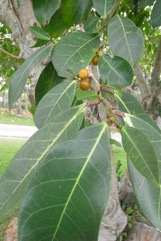Dye fig

A tropical plant. Trees are common on limestone or coral rocks near the sea shore. It tends to be on coral soils. In the Pacific it grows from sea level to 750 m altitude.
Also known as:
Awal, Awan, Awann, Awen, Coain, Felo, Gawal, Guwan, Gawann, Hawan, Hmei-thai-thei, Hoda, Hodda, Hotda, Howel, Kiro kesik, Mai-hai-sa-pye, Mati, Mok, Nihn, Nin, Nunu, Nyaung-thabye, Oseked, Oseched, Savirewa, Srah, Tagete, Topdo, Te bero, Topodo, 'U'apea, Wach'guy, Wachaguy, Xie ye rong
Synonyms
- Ficus chlorosykon Rechinger
- Ficus validinervis Benth.
Edible Portion
- Fruit, Leaves
Where does Dye fig grow?
Found in: American Samoa, Asia, Australia, Bhutan, Caroline Islands, China, Chuuk, Cook Is., East Timor, FSM, Fiji, Guam, Himalayas, India, Indochina, Indonesia, Kiribati, Laos, Malaysia, Marshall Islands, Micronesia, Myanmar, Nauru, Nepal, Niue, Northeastern India, Pacific, Palau, Papua New Guinea, PNG, Philippines, Pohnpei, Rotuma, Samoa, SE Asia, Solomon Islands, Sri Lanka, Thailand, Timor-Leste, Tokelau, Tonga, Tuvalu, Vanuatu, Vietnam, Wallis & Futuna
Notes: There are about 800-1000 Ficus species. They are mostly in the tropics. There are 120 Ficus species in tropical America.
Status: Mostly reported as a wild occasional food on the Gazelle Peninsula and New Ireland in Papua New Guinea. It is an important food in Kiribati, Tuvalu and Micronesia.
Growing Dye fig
Cultivation: It normally grows wild. It grows from seed. It can also be grown from cuttings.
Edible Uses: The young tips are picked and eaten. The fruit are eaten cooked. They are often cooked in coconut milk. They can be dried and crushed and made into a puree by sweetening with coconut toddy.
Production: In Australia, fruit are produced in May to July.
Nutrition Info
per 100g edible portion| Edible Part | Energy (kcal) | Protein (g) | Iron (mg) | Vitamin A (ug) | Vitamin c (mg) | Zinc (mg) | % Water |
|---|---|---|---|---|---|---|---|
| - | - | - | - | - | - |
Dye fig Photos





References
Altschul, S.V.R., 1973, Drugs and Foods from Little-known Plants. Notes in Harvard University Herbaria. Harvard Univ. Press. Massachusetts. no. 735
Borrell, O.W., 1989, An Annotated Checklist of the Flora of Kairiru Island, New Guinea. Marcellin College, Victoria Australia. p 107
Clarke, W.C. & Thaman, R.R., 1993, Agroforestry in the Pacific Islands: Systems for sustainability. United Nations University Press. New York. p 238
Cowie, I, 2006, A Survey of Flora and vegetation of the proposed Jaco-Tutuala-Lore National Park. Timor-Lests (East Timor) www.territorystories.nt/gov.au p 50
Englberger, L., et al, 2005, Carotenoid content of pandanus fruit cultivars and other foods of the republic of Kiribati. Public health nutrition 9(5), 631-643
Flora of Australia, Volume 3, Hamamelidales to Casuarinales, Australian Government Publishing Service, Canberra (1989) p 60
Flora of China.
Fl. ins. austr. 76. 1786
Franklin, J., Keppel, G., & Whistler, W., 2008, The vegetation and flora of Lakeba, Nayau and Aiwa Islands, Central Lau Group, Fiji. Micronesica 40(1/2): 169–225, 2008
French, B.R., 1986, Food Plants of Papua New Guinea, A Compendium. Asia Pacific Science Foundation p 64
Gillaumin, R., 1954, Les Plantes utiles des Nouvelles-Hebrides (fin et complement) In: Journal d'agriculture tropicale et de botanique appliquee Vol. 1, No. 10-12 pp 453-460 (As Ficus neoehudarum)
Hariyadi, B., 2008, The Entwined Tree: Traditional Natural Resource Management of Serampas, Jambi, Indonesia. Ph. D thesis. Univ. or Hawaii. p 402
Jansen, A. A. J., et al, (Eds), 1990, Food and Nutrition in Fiji. Volume One. p 52
Kar, A., et al, 2013, Wild Edible Plant Resources used by the Mizos of Mizoram, India. Kathmandu University Journal of Science, Engineering and Technology. Vol. 9, No. 1, July, 2013, 106-126
Lebot, V. & Sam, C., Green desert or ‘all you can eat’? How diverse and edible was the flora of Vanuatu before human introductions?. Terra australis 52 p 408
Liefting, A., et al, Samoan plant names. http://en.wikipedia.org
Miquel, F.A.W., 1848, London Journal Botany 7: t 6B
Paczkowska, G . & Chapman, A.R., 2000, The Western Australian Flora. A Descriptive Calatogue. Western Australian Herbarium. p 332
Peekel, P.G., 1984, (Translation E.E.Henty), Flora of the Bismarck Archipelago for Naturalists, Division of Botany, Lae, PNG. p 147, 146
Reis, S. V. and Lipp, F. L., 1982, New Plant Sources for Drugs and Foods from the New York Botanical Garden herbarium. Harvard. p 44
Smith, A.C., 1981, Flora Vitiensis Nova, Lawaii, Kuai, Hawaii, Volume 2 p 191
Stone, B.,
Thaman, R. R., 1987, Plants of Kiribati: A listing and analysis of vernacular names. Atoll Research Bulletin No. 296
Thaman, R. R., et al, 1994, The Flora of Nauru. Atoll Research Bulletin No. 392. Smithsonian Institute p 173
Thaman, R. R, 2016, The flora of Tuvalu. Atoll Research Bulletin No. 611. Smithsonian Institute p 101
Walter, A. & Sam C., 2002, Fruits of Oceania. ACIAR Monograph No. 85. Canberra. p 169, 279
Wheeler, J.R.(ed.), 1992, Flora of the Kimberley Region. CALM, Western Australian Herbarium, p 83
Whistler, A. S., Edible vascular plants of the Line Islands. Pacific Health Dialog. Vol. 3 No. 2
Whistler, W. A., 1988, Ethnobotany of Tokelau: The Plants, Their Tokelau Names, and Their Uses. Economic Botany 42(2): 155-176
Whistler, W.A., 2004, Rainforest Trees of Samoa. Isle Botanica Honolulu, Hawaii. p 109
World Checklist of Useful Plant Species 2020. Royal Botanic Gardens, Kew
Yuncker, T.G., 1959, Plants of Tonga, Bernice P. Bishop Museum, Hawaii, Bulletin 220. p 101